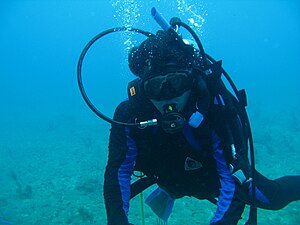 Image by Dude Crush via Flickr
Image by Dude Crush via Flickr
How Deep Can I Go With Standard Scuba Equipment?
Firstly, a little disclaimer: Just because you can go a certain depth does certainly not mean it is safe, especially if you do not have the appropriate training and experience for that depth.
With standard scuba equipment you have a maximum depth of approximately 60m (195ft). This is because, after this depth the pressure exerted on the oxygen in your air supply becomes toxic, going further or experiencing this toxicity for too long could prove fatal. At depths between 30-60m, while not dangerous in itself, is likely to bring on the onset of nitrogen narcosis which can have a severe impact on a diver's decision making, leading to stupid and sometimes dangerous actions.
As we mentioned, oxygen at higher partial pressures (1.44bar to be exact) become toxic. Aside from this, the diver must also be aware since their air is getting compressed, it will provide fewer "breaths" and will of course, run out a lot quicker than if he or she were diving at a shallower depth.
PADI recommend that the absolute maximum depth for a recreational diver is 40m (130ft), while BSAC recommend a maximum depth of 50m (165ft) with proper training.
Is Diving Deep Important?
The short answer to this is, no - diving deep is not important for the recreational diver most of the time. The shallower you are, the more bottom time you'll have and the less you'll have to worry about - a more pleasant experience for all.
Keep in mind the "mission" of your dive when you plan it. There's a lot of things to see at depths less than 40m (130ft). It maybe be necessary though, if a diver is specifically doing a recovery dive or viewing a wreck that they just didn't damn sink at a sensible depth to go deeper. In these cases it is important that you are well versed with your scuba gear, the effects of nitrogen narcosis and know you your limits in terms of experience and ability and of course, of your buddy too.
So How Deep Can You Go With Specialist Equipment?
There are specialised pieces of scuba diving equipment that make it possible to overcome deep diving problems such as nitrogen narcosis, oxygen toxicity and the tremendous pressure you can face at extreme depths.
It is possible to technical divers to go as deeper than 200m (700ft) with closed circuit rebreathers. As we discussed earlier, oxygen at high pressures becomes toxic, so these divers also use mixed gas, the usual mix is helium and oxygen, which eliminates the nitrogen narcosis problem, but does leave you sounding like tweety bird when you talk!
Commercial divers, can operate at these depths (200m/700ft+), for incredibly long periods of time. They will typically work 6-7 hours per day, but stay under the water for up to a month at a time! Rather than waste time decompressing, these guys essentially "live" in compression chambers while they're not diving. These compressors can be on a ship, or in some cases, sunken to be near the dive site.
Thanks to the Scuba Site for this article.
Kathy Dowsett
www.kirkscubagear.com






